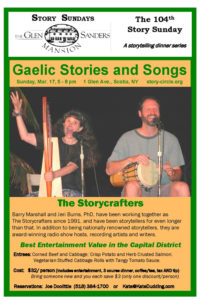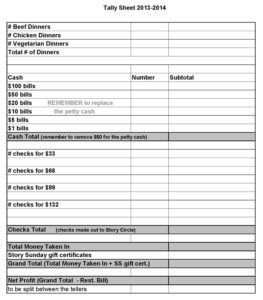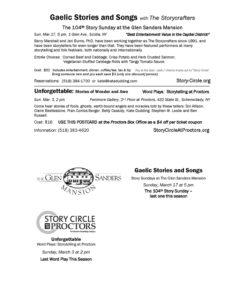PRO SIG Preconference, NSN 2013 Conference, Richmond, VA
July 2013
by Kate Dudding
Summary
Description of the process and success in creating a venue for storytelling to adults; expanding listener base; and sharing lessons learned during fourteen seasons of a dinner storytelling series: “Story Sundays at the Glen Sanders Mansion.” Includes how-to ideas about promotion, marketing, logistics and expansion, as well as example postcards, flyers, etc.
Best Practice: It’s easier to build on things that exist than to start from scratch
- Existing audience – maintain a database of listeners, especially their email addresses
Situation in Fall 1999
- Story Circle of the Capital District of New York had produced 3 successful Tellabrations (audiences 300-400 per Tellabration, 30 volunteers per Tellabration) held in a church which often including storytelling in their services
- Mailing list established (500 names)
- Pool of LOCAL storytellers Pitfall: non-local tellers, even great ones, don’t draw listeners at Story Sundays
- Story Circle – a guild organized in 1983 as a support group providing informal feedback for works in progress
- Most venues geared mostly to children/youth, schools and libraries
- Little shared marketing, although much energy
- Well-known venue
Plan and Implementation
- A chance remark, made before Tellabration ’99, becomes a pilot
- Owner of venue a former neighbor
- Venue site for weddings, community events, non-profit events plus it has a fine restaurant
- People who come to these events come to our event (people go where they’ve been before) – mature audience
- Picked strong performers with local followings
- Sent direct mail to our storytellers and Tellabration mailing list
- Chose the dates to fit around Tellabration 2000
- “Story Sundays at the Glen Sanders Mansion” monthly adult storytelling dinner series
- Historic site, excellent reputation regionally for ambiance, and it has its own story
- Service and food quality an attractive draw by themselves
- Viewed as a private party by the Glen Sanders Mansion glensandersmansion.com
- Viewed as “filler” by the Glen Sanders Mansion management when other banquet/wedding opportunities sparse (i.e. fall/winter/early spring)
Best Practice: Offer something else in addition to the storytelling – in our case: dinner
- Logistics
- Usually 2 tellers/theme/evening (see list of programs in Appendix 1), 40-80 listeners per
- 5:00 PM to 8: 00 PM, cash bar and dinner. Four courses story interwoven with three courses of food (soup/salad, main course and dessert). The plates for each course are picked up before the next story set starts. No coffee/tea service during the stories
Best/Tricky Practice: Setting the price so tellers get decent money yet the event is not too pricey for potential listeners
Cost: originally $20, now $33 (includes entertainment,3 course meal, coffee/tea, tax AND tip); setting cost $7 above the cost of the meals works well for us. After meals paid for, balance goes to tellers/production costs (with 70 paid tickets, each of the two tellers gets $150 and a free meal)
- Shared promotion with Tellabration in Fall
- Reservation telephone number and email address for menu selection (only 3 choices for cost control). People pay at the door (cash or check, per request of restaurant)
Best Practice:
Our room setup so people can see tellers
Tables not fully set up – allows last minute flexibility in keeping parties together Have a mic – needed for our mature audience
There is a stage (needed for our short listeners) and a microphone (needed for our elderly listeners). The rectangular tables are placed with their narrow ends of the tables pointing toward the stage. While the tables can seat 10, we normally only seat 8 per table, removing the 2 seats nearest the stage, where the listeners would have their backs to the tellers.
Pitfall: Can’t do the same thing over and over – you need to make things different so people want to come to EACH event
Best Practice: When attendance starts dropping, do something different – in our case a discount to newbies/people bringing newbies. Notice which events/tellers have the best attendance: for us, love stories in February, Irish stories in March.
Recent promotion to attract new listeners: Save $3 if you’ve never come to Story Sundays (a welcome to Story Sunday discount). Save $3 if you bring someone who has never come to Story Sundays (a thanks for bringing someone new aka finders fee discount). Only one $3 discount per person. People really like this…???…
- See Appendix 2 for explicit instructions on how to run a Story
Pitfall: low attendance during the good weather months – we now avoid them
Reserve banquet rooms for the Oct.-Mar. season the previous May. Start booking tellers. Establish the menus for the entire season.
Best Practice: have the season set up by early June – that’s when Red Hatters and other groups are scheduling THEIR next year’s worth of meetings
Best Practice: Find a sponsor whose clients match your demographic – in our case a wealth management stock broker His firm is acknowledged on web site (name and link), season’s postcard and the email notices
Best Practice (from our other series for adults held in a performing arts center): Use the venue’s 501 3c to collect donations and apply for (non-competing) grants
- Success/feedback
- Tellabration audience clearly wanted more storytelling
- Glen Sanders Mansion a draw
- Interested and supportive staff at Glen Sanders Mansion
- Tellers enthusiastic
- Producing is “work”; takes time and knowledge – not a one person job
- Programs enhanced by music, although not every program includes music
Pitfall: Since we are in a tri-city area, we tried expanding to a second restaurant in another city 10 miles away, but we never established a new listener base there.
Story Circle as Production Company
- Story Circle Productions coincidentally forming a not-for-profit production company to sponsor Tellabration; share/use infrastructure between Tellabration and dinner series
- Distinct from guild’s monthly meetings
Best Practice: use multiple people with different skill sets (and learn to appreciate your differences)
- Jobs: go with the strengths of your people
Producer (big picture person, well connected within community)
- Shapes direction and growth of the series
- Interfaces with Glen Sanders Mansion and tellers
Producer (detail person, organized)
- MC most months
- Involves community organizations
- Produces high quality postcards (see Appendix 3, sent to people without email addresses) and flyers (Appendix 4)
- Mailings for each program to local newspapers’ entertainment One paper requires faxes – always ask first how information should be sent and to whom before sending information to a newspaper.
Best Practice: if you want newspaper coverage, read every issue of that newspaper for at least a week looking for where your event fits and how similar community organizations are treated
Unique email to columnist who writes about food events, using HIS format, in Sept. and Jan.
- Maintains US mailing list (currently 1,500 names and addresses) and email list (570 names) — not including Story Circle members. See Appendix 7 for the structure of the mailing list. Uses Constant Contact to send out monthly emails
- Each month provides a packet for each table: 6 copies of the most recent flyer, plus a satisfaction survey for each person (see Appendix 5) , plus a join our mailing list form (see Appendix 7).
- Greets and sells tickets at the door with a helper, helps with MC’ing,
- Creates and maintains web site: story-circle.org
- Where our audience comes from
Best Practice: Screw up your courage and call the media person in charge – find out their interests, how far they plan ahead, etc.
- Articles after calling/meeting with Entertainment Editor
- Word of mouth –most important source
- Mailings
- Newspaper calendars
- Newspaper column on food events
- Tellabration
- Senior groups
- Library staffs
- Couples groups
- Red Hat Ladies
- Book clubs
- Not-for-profit benefit programs
- Church groups
Evaluation/Feedback/Lessons Learned After 14 Seasons
- Over 100 Story Sunday dinner productions ( 7,000 listeners)
- Successful combination: storytelling with good food and ambiance
- Handicap access required for this mature audience
- Vegetarian selection needed
- Conversation at the tables is usually vibrant, involving everyone at the tables, including those who were strangers at the beginning of the evening
Best Practice: Occasionally have a benefit program for a local organization which exposes their supporters to storytelling
- Value in shared marketing with Tellabration and storytelling at other venues – we swap ad space in programs of a nearby Tellabration and a festival
Best Practice: Swap ads with other local storytelling groups
- Choose a restaurant with a separate banquet room and experience in catering private parties
Best Practice: Reduce productions costs as much as possible – postcards only to non-email people sent out via click2mail.com and one of our producers already pays for ConstantContact.com for our email distribution
Pitfall: While increasing the number of tellers might bring in all their friends, all of the tellers’ free dinners really cut into the profit which, in turn, has to be split into many more pieces. So we usually have two tellers max.
Biographies
Storytellers Joe Doolittle and Kate Dudding have been producing storytelling events in New York State’s Capital Region since 1997. They also produce the local Tellabration, have another series for adults at the local arts center and produce a monthly one hour TV show about local storytellers and storytelling on public access television. Over 9,000 people have attended their 150+ productions.
Storyteller Kate Dudding creates entertaining, heartwarming and memorable stories about real people who made a difference. She has told stories at many venues in the Northeastern USA. Each of her three CDs has received a national storytelling award. In 2010, she won the story slam at the National Storytelling Conference in Los Angeles.
Kate Dudding, 8 Sandalwood Drive, Clifton Park 12065 (518) 383-4620 www.katedudding.com
Alden T. (Joe) Doolittle has used storytelling in staff development, training and graduate education. As a health care management consultant, he employs storytelling with clients and regional audiences and with diverse audiences as a Sunday school teacher at Schenectady’s First Reformed Church and volunteer chaplain at the Albany Medical Center.
Alden (Joe) Doolittle, 112 Maplewood Drive, Scotia, New York 12302 (518) 399-0499
Appendices
Appendix 1: Fourteen Seasons of Story Sunday Programs
See http://www.storycircleatproctors.org/sc/Story Sundays – past seasons.shtml
Appendix 2: How to Run a Story Sunday
On arrival at The Glen Sanders Mansion
- Introduce yourself to the servers and the bartender
- Put out flyers and satisfaction surveys and mailing list sign up forms on the tables (8 people per table)
- Put a Reserved Sign on a table for the tellers and on other tables for any group of 4 or more
- Put the following on reception table:
- Meal tickets (all 3 flavors (beef, chicken, veggie), numbered tickets/flavor in order) – used to keep track of how many people are attending
- Extra pens
- Tellers’ CDs and tapes for sale
- $50 in petty cash
- Reservation list from Joe Doolittle
- Make sure there’s a step to the stage near the FRONT edge of the stage (so tellers don’t clunk their heads on the low ceiling) and that the mic is
Meet and Greet the Tellers
- Show them where they’ll be sitting and telling
- Do a mic check
- Get the timing for their sets (before salad, before entrée, before dessert) and give this info to the head server
- Ask how they want to be introduced and who is starting each set
- Give them each a meal ticket and take one for yourself and for your helper
- Share with them how the listeners appreciated Tom Weakley when he visited each table during the meal
Greeting Story Sunday Listeners
- Smile and welcome people
- Ask if they are attending for the first time. If so, They get in for $30, a $3 discount
If they were brought by someone who has attended Story Sunday before,
The bringer also gets in for $30 (a $3 discount as a finders’ fee – only one discount per person)
- Have the listeners make their checks out to “Story Circle
- Check off their names on the reservation list
- Have each listener take a meal ticket (beef, chicken or veggie) – they can make changes from their reservation – it all works
- Start the storytelling when there is no longer anyone coming in and hopefully everyone who has made a reservation has arrived. But there are some no shows, so don’t wait for everyone. Start by 5:15 at the very
- Also walk-ins are also OK. They counterbalance the no-shows.
- MAKE A NOTE ON THE TALLY SHEET (Appendix 8) OF HOW MANY ARE EATTING EACH TYPE OF DINNER. If the topmost tickets are: Beef 22, Chicken 14, Veggie 6, then note down Beef 21, Chicken 13, Veggie 5. Therefore 21+13+15 =49 people are attending this performance
During the Program
- Introduce the First Set
- Welcome people and thank them for telling their friends about Story Sundays
- Explain the 4 courses of stories interwoven with 3 courses of food
- Introduce the tellers
- Introduce the Second Set AFTER all the salad plates have been cleared
- Introduce the Third Set AFTER all the dinner plates have been cleared
Go over the handouts on the tables, especially talking about the next Story Sunday
- Introduce the final 2-3 minute bit by 7:50 (people will probably be eating dessert still)
After the Program
- Ask the head server for the bill. We pay $26 per dinner, no tax nor gratuity
- Put the $50 petty cash back in the Story Sunday box (just a small box 5 x 11 x 2 from Office Max)
- Make sure the bill is for no more dinners than the dinners you know about – see the tally sheet
- Pay the bill using a credit card of one of the Write the producer a check.
- Spilt the profits between the tellers and pay them in
- Put the checks and remaining cash in the Story Sunday Deposit them the next day in the checking account.
- Pick up the leftover flyers, satisfaction surveys and Reserved signs and return them to the Story Sunday box
- Put the Glen Sanders receipt and the tally sheet the Story Sunday box
Appendix 3: Monthly Postcard
Sent via https://click2mail.com/ 200 B&W double-sided postcards: $82 (includes printing and postage)
Appendix 4: Monthly Flyer

Appendix 5: Monthly Satisfaction Survey
Story Sunday Satisfaction Survey
|
Since there’s always room for improvement, would you please help us by answering these questions? Please rate the food. (One being lowest, ten being highest)
How would you describe this evening to a friend?
What one thing would you change?
Do you have any specifics comments for our tellers?
How did you hear about Story Sundays?
Thank you so much, both for coming and for your comments. Joe Doolittle and Kate Dudding, Producers
Appendix 6: Microsoft Access Database
This is used to keep track of who has attended which performances and to generate mailing labels and list of email addresses. We only send postcards to those without email addresses.
We also used this database to examine the habits of our audience. We discovered that not many people attend both Tellabration and Story Sundays. We’re now sending Story Sunday postcards to the recent Tellabration audiences, in addition to highlighting Story Sundays in the Tellabration program.
Columns (Fields) in the Database: First Name(s)
Last Name Street Address City
State Zip
Email Address Tellabration 99 1st Season Tellabration 2000 2nd Season Tellabration 2001
3rd Season: Scotia
3rd Season: greater Albany etc.
Appendix 7: Mailing List Sign Up Sheet
Story Circle of the Capital District
Mailing List
If you’d like to hear about future performances, please sign below. Thanks. (We do not rent or sell our mailing list to any other organization.)
| Name | ||
| Street | ||
| Town | State | Zip |
| Name | ||
| Street | ||
| Town | State | Zip |
| Name | ||
| Street | ||
| Town | State | Zip |
| Name | ||
| Street | ||
| Town | State | Zip |
| Name | ||
| Street | ||
| Town | State | Zip |
| Name | ||
| Street | ||
| Town | State | Zip |
Appendix 8: Tally Sheet


